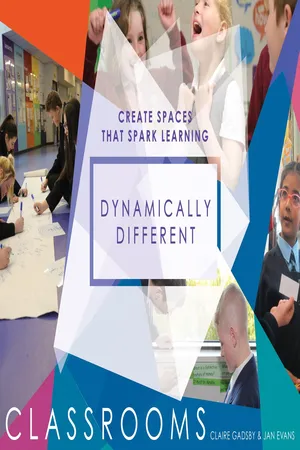
- 176 pages
- English
- ePUB (mobile friendly)
- Available on iOS & Android
About This Book
In Dynamically Different Classrooms: Create spaces that spark learning, Claire Gadsby and Jan Evans provide teachers with a visually striking masterclass on how to maximise the potential of every cubic inch of the learning environment.
Classrooms are private places. A lucky few - consultants and inspectors among them - get to visit hundreds of classrooms a year, yet many teachers never get the opportunity to see how other practitioners 'do it'.
In Dynamically Different Classrooms, however, experienced educators Claire and Jan take away the guesswork by inviting teachers into a unique journey of classroom discovery that shows them how to design and use the space within their classroom in such a way that enhances their pupils' learning experiences.
Bursting with a rich variety of practical ideas, this inspiring guide to the great indoors talks you through the 'clue corners', 'ceiling circuits' and 'windows of opportunity' waiting to be discovered in your classroom and shares 148 high-impact techniques proven to boost pupils' engagement, long-term learning and progress.
The techniques are dispersed across five chapters - each covering a specified aspect of the classroom (e.g. wall displays) - and are tagged to cross-reference with the following six key themes in order to help you navigate your own pathway through the chapters according to your development priorities:
Metacognition and self-regulated learning
Emotional engagement
Retrieval and revision
Responsive teaching
Oracy and 'word wealth'
Collaborative learning.
The strategies can be adapted for use with all age groups and will stimulate busy teachers to reimagine the learning space through a more creative lens. Each theme is underpinned by robust research in the book's introduction, in which the authors discuss the key findings and explore how effective classroom design can help unlock the potential of various pedagogical approaches.
The book also features a range of illuminating case studies from various schools across the UK, and is beautifully decorated with full-colour photographs that capture the techniques in action to make it even easier for you to adopt and adapt these design principles in your own dynamically different classroom.
Suitable for teachers, trainees, teaching assistants and senior leaders in both primary and secondary schools.
Chapters include: Chapter 1 - Beyond displays: from static to dynamic; Chapter 2 - Nothing wasted: storing learning to resurrect and revive later; Chapter 3 - Floors: not just for standing or sitting on; Chapter 4 - Zoning: one classroom, endless possibilities; Conclusion: the legacy of the learning.
Customer Notice: this book contains a large amount of full colour images, therefore any digital version would be better rendered by being viewed using a device with a colour display.
Frequently asked questions
Information
BEYOND DISPLAYS: FROM STATIC TO DYNAMIC


In this chapter
Sound familiar?


So what needs to happen?
Repurposing






Reweighting
Table of contents
- Cover
- Praise
- Title Page
- Dedication
- Acknowledgements
- Contents
- Introduction
- Chapter 1: Beyond displays: from static to dynamic
- Chapter 2: Nothing wasted: storing learning to resurrect and revive later
- Chapter 3: Floors: not just for standing or sitting on
- Chapter 4: Zoning: one classroom, endless possibilities
- Conclusion: the legacy of the learning
- References and further reading
- List of strategies
- About the authors
- Copyright